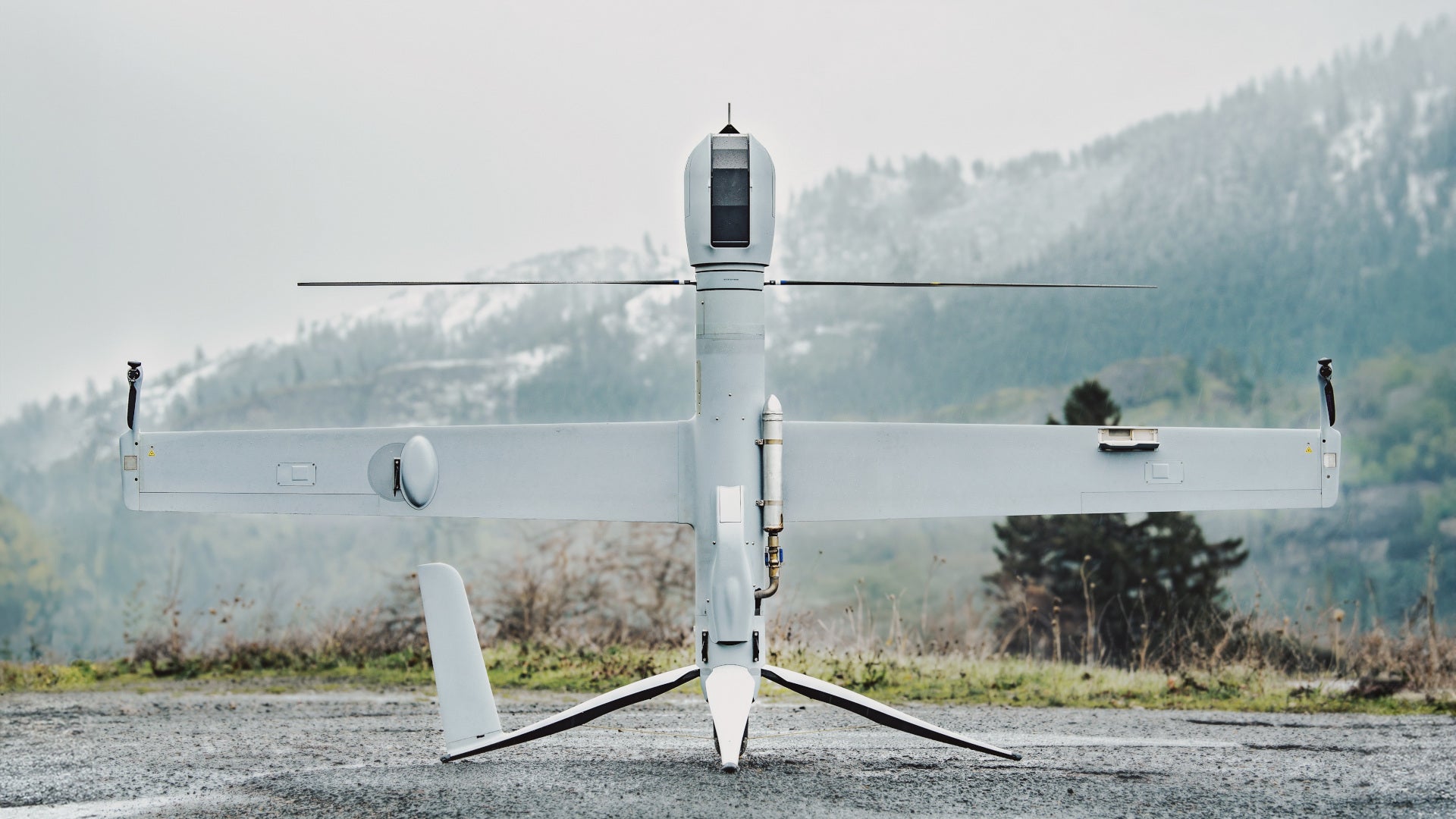Airbus, a top manufacturer of commercial jets, is looking to expand its uncrewed aerial systems (UAS) portfolio.
The French OEM on Monday announced its intent to acquire Aerovel, manufacturer of the Flexrotor tactical drone, through its subsidiary Airbus Helicopters. The drone—designed for intelligence, surveillance, target acquisition, and reconnaissance (ISTAR)—is expected to join Airbus’ UAS roster by the end of the year, the manufacturer said, pending regulatory approval.
Flexrotor is a Group 2 small tactical UAS with vertical takeoff and landing (VTOL) capability, built for ISTAR operations for the U.S. and its allies over land or sea, day or night. It will join Airbus’ fleet of high endurance uncrewed aircraft, such as the self-flying VSR700 helicopter or Eurodrone. Aerovel will remain an American-owned company and work with the U.S. Department of Defense (DOD) under Airbus’ Special Security Agreement.
The planned transaction follows the addition of a dedicated business line for military UAS by Airbus U.S. Space & Defense, which aims to deploy the aircraft for the DOD. The expansion was announced in November.
“This strategic acquisition aligns with our vision to expand our UAS offering and respond to a growing customer demand worldwide for additional mission capabilities such as manned-unmanned teaming,” said Bruno Even, CEO of Airbus Helicopters. “Aerovel’s expertise in autonomous flight technology will undoubtedly complement our UAS development with the VSR700, as well as the work that we have been doing to develop interoperability.”
According to Aerovel, Flexrotor combines compact size, heavy payload capacity, long range, and autonomy. It’s designed to meet the rigor of DOD specifications, capable of protecting military bases through threat detection and real-time imagery, for example. But it’s also meant to be cost-effective for commercial markets, which could deploy it for security or law enforcement applications.
Flexrotor is powered by a 28 cubic centimeter, two-stroke engine. The high-endurance drone can fly autonomously for more than 30 hours or up to 1,100 nm, reaching a top level speed of 77 knots. At its max launch weight of 55 pounds, it can cruise in fixed-wing mode at 21,000 feet agl. And crucially, its ability to take off and land vertically means it requires only a 12-by-12-foot space for launch and recovery.
The UAS uses a steerable, zoomable imaging turret with cameras to perform searches and collect video for real time or later viewing. In addition, Flexrotor is payload agnostic, allowing users to swap out certain sensors or other components. It can also communicate with receivers nearly 75 miles away and be assembled or stored in minutes, making it a flexible option for customers.
Though it’s designed for ISTAR missions and is backed by the DOD, Flexrotor is malleable enough to take on semi-public missions, such as tracking forest fires or guiding ships through ice in the Arctic Ocean.
“Joining forces with Airbus will allow us to scale innovation, accelerate our mission to advance unmanned aviation, and maintain our unwavering support for the U.S. military and its allies,” said Ali Dian, CEO of Aerovel. “We are proud to become part of an organization with a rich legacy of aerospace excellence and we look forward to leveraging our combined strengths to define the future of autonomous systems.”
Aerovel’s versatile UAS will join Airbus’ existing portfolio of uncrewed products, which is steadily growing.
SIRTAP, the company’s high-end tactical UAS for civil and military use cases, was recently picked by the Spanish Ministry of Defense to bolster the country’s armed forces. It ordered a total of nine systems and two simulators, with a prototype maiden flight planned for 2025.
Airbus also develops Eurodrone, which it bills as the first UAS built to fly in nonsegregated airspace. Eurodrone—a joint project between the governments of Germany, France, Spain, and Italy under the Organization for Joint Armament Cooperation (OCCAR)—will carry out defense missions in civil airspace. Dassault Aviation and Leonardo are also involved in development.
Both SIRTAP and Eurodrone will be part of the Future Combat Air System (FCAS) project, which is a multinational collaboration to replace existing combat systems (including Airbus’ Eurofighter) with new technology by 2040. FCAS will be built around next-generation fighter jets, which will communicate with uncrewed remote carriers using a data platform called the Combat Cloud.
Airbus is co-leading the entire program, spearheading vehicle development for the remote carriers and data platform. The company will use its A400M mothership and A330 Multi-Role Tanker Transport (MRTT) to deploy up to 50 remote carriers at once, helping them communicate with crewed aircraft using Combat Cloud. It’s also developing Manned-Unmanned Teaming software, which is designed to coordinate crewed and uncrewed platforms.
Beyond its FCAS projects, Airbus produces the VSR700 and Zephyr, a fixed-wing, uncrewed high-altitude platform station (HAPS). Zephyr can fly in the stratosphere for months at a time. In 2022, it surpassed all known endurance records for a UAS of its class during a 64-day, 30,000 nm flight.
In addition, Airbus produces a few small tactical UAS: the Aliaca for coastal surveillance, the DVF 2000ER for heavy endurance, and the CAPA-X for all kinds of military missions. It also builds target drones and simulators for military training and offers DeckFinder, a software that guides drones to safe landings.
Beyond UAS, Airbus is exploring other emerging forms of aviation. On Tuesday, for example, the company announced it successfully powered up ZEROe—a hydrogen propulsion system for its electric concept aircraft—in full for the first time. Earlier in the month, it finalized a joint venture to design, build, and operate the Starlab commercial space station.
At the same time, the manufacturer continues to set the bar for traditional aviation. Last week, it revealed it secured a company record 2,094 aircraft orders in 2023, topping rival Boeing in that metric for the fifth consecutive year.
Like this story? We think you’ll also like the Future of FLYING newsletter sent every Thursday afternoon. Sign up now.
